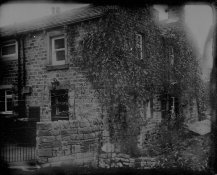Simon Howers
Member
Just a quick note on this material.
I applied emulsion melted at 40 deg C onto previously subbed plates.
Subbing solution was fresh gelatine/chrome alum.
2 x glass plates were cleaned with rottenstone and detergent, dried and subbed.
Metal plate was painted with acrylic black and swabbed with iso propyl alcohol.
Emulsion coating really only works if plate is pre-warmed to assist pouring & drainage.
(See the tin plate below for an example of a cool plate)
Plates left to harden for two days.
Exposure at ISO 10 (half second at F11 in overcast conditions.)
Processing:
All - developed by inspection in trays.
Tin plate developed in Rockland reversal developer for 2 mins then cleared in Kodak hardening fixer.
Glass plates - one developed in Rockland reversal developer for 2 mins to produce ambrotype and cleared in Kodak hardening fixer.
Second glass plate developed in XTOL for about 2 mins, stopped in Ilfostop and cleared in Kodak hardening fixer.
Results: This emulsion handles easily and can be applied economically. ISO 10 is rather better than some others I have tried. It produces nice detailed and clean negatives in XTOL.



Hopefully the thumbnails appear as 'negative', 'ambrotype', 'tintype'
(you can see on the tintype where I failed to pour all the excess off the plate and the emulsion has crazed.)
These were all 5x4 for testing. Wholeplate negs are lovely.
Simon
I applied emulsion melted at 40 deg C onto previously subbed plates.
Subbing solution was fresh gelatine/chrome alum.
2 x glass plates were cleaned with rottenstone and detergent, dried and subbed.
Metal plate was painted with acrylic black and swabbed with iso propyl alcohol.
Emulsion coating really only works if plate is pre-warmed to assist pouring & drainage.
(See the tin plate below for an example of a cool plate)
Plates left to harden for two days.
Exposure at ISO 10 (half second at F11 in overcast conditions.)
Processing:
All - developed by inspection in trays.
Tin plate developed in Rockland reversal developer for 2 mins then cleared in Kodak hardening fixer.
Glass plates - one developed in Rockland reversal developer for 2 mins to produce ambrotype and cleared in Kodak hardening fixer.
Second glass plate developed in XTOL for about 2 mins, stopped in Ilfostop and cleared in Kodak hardening fixer.
Results: This emulsion handles easily and can be applied economically. ISO 10 is rather better than some others I have tried. It produces nice detailed and clean negatives in XTOL.



Hopefully the thumbnails appear as 'negative', 'ambrotype', 'tintype'
(you can see on the tintype where I failed to pour all the excess off the plate and the emulsion has crazed.)
These were all 5x4 for testing. Wholeplate negs are lovely.
Simon











